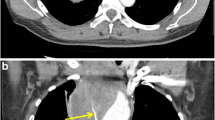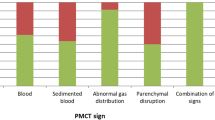Abstract
A 77-year-old woman who had been in the hospital suffering from a subarachnoid hemorrhage suddenly died after undergoing a cerebral aneurysmal operation. Postmortem whole-body computed tomography (CT) demonstrated multiple lung tumors with abnormal masses in the bronchus with no evidence of complications in the cranium. The patient was estimated to have died from asphyxia caused by metastatic lung and endobronchial tumors. Although a traditional autopsy was not performed, postmortem CT provided strong evidence for detecting the cause of death. In this case, postmortem CT played an important role in hospital risk management.
Similar content being viewed by others
References
Mitka M. CT, MRI scans offer new tools for autopsy. JAMA 2007;298:392–393.
Ezawa H, Yoneyama R, Kandatsu S, Yoshikawa K, Tsuji H, Harigaya K. Introduction of autopsy imaging redefines the concept of autopsy: 37 cases of clinical experience. Pathol Int 2003;53:865–873.
Kaidou T. Ai no gainen, rekishi. In: Ohtomo K, editor. Autopsy imaging dokuei guide. Tokyo: Bunkoudou; 2009. p. 2–23 (in Japanese).
Arai A, Shiotani S, Yamazaki K, Nagata C, Kikuchi K, Suzuki M, et al. Postmortem computed tomographic (PMCT) and postmortem magnetic resonance imaging (PMMRI) demonstration of fatal massive retroperitoneal hemorrhage caused by abdominal aortic aneurysm (AAA) rupture. Radiat Med 2006;24:147–149.
Ikeda G, Yamamoto R, Suzuki M, Ishiwaka H, Kikuchi K, Shiotani S. Postmortem computed tomography and magnetic resonance imaging in a case of terminal-stage small cell lung cancer: an experience of autopsy imaging in tumor-related death. Radiat Med 2007;25:84–87.
Shiotani S. II. PMCT shoureiteiji. Case 2. Hukukuunai-zoukisonnshou. In: Ezawa H. Shiotani S, editors. Autopsy imaging [gazou kaibou]. Tokyo: Bunkoudou; 2004. p. 72–75 (in Japanese).
Shiotani S, Yamazaki K, Kikuchi K, Nagata C, Morimoto T, Noguchi Y, et al. Postmortem magnetic resonance imaging (PMMRI) demonstration of reversible injury phase myocardium in a case of sudden death from acute coronary plaque change. Radiat Med 2005;23:563–565.
Aghayev E, Sonnenschein M, Jackowski C, Thali M, Buck U, Yen K, et al. Postmortem radiology of fatal hemorrhage: measurements of cross-sectional areas of major blood vessels and volumes of aorta and spleen on MDCT, and volumes of heart chambers on MRI. AJR Am J Roentgenol 2006;187:209–215.
Shojania KG, Burton EC, McDonald KM, et al. Changes in rates of autopsy-detected diagnostic errors over time: a systemic review. JAMA 2003;289:2849–2856.
Park CM, Goo JM, Choi HJ, Choi SH, Eo H, Im JG. Endobronchial metastasis from renal cell carcinoma: CT findings in four patients. Eur J Radiol 2004;51:155–159.
Author information
Authors and Affiliations
Corresponding author
About this article
Cite this article
Takahashi, N., Higuchi, T., Shiotani, M. et al. Multiple lung tumors as the cause of death in a patient with subarachnoid hemorrhage: postmortem computed tomography study. Jpn J Radiol 27, 316–319 (2009). https://doi.org/10.1007/s11604-009-0340-5
Received:
Accepted:
Published:
Issue Date:
DOI: https://doi.org/10.1007/s11604-009-0340-5




